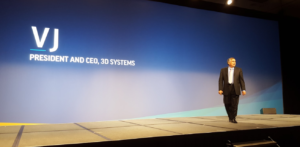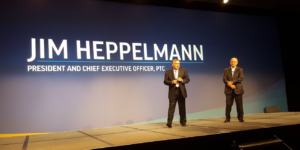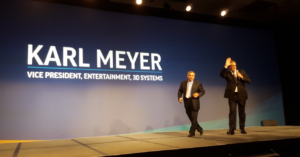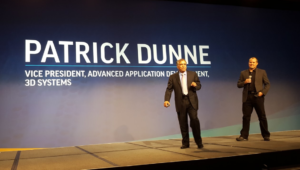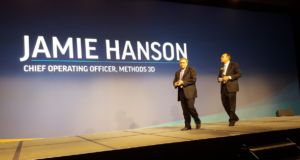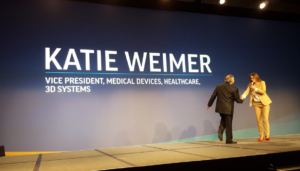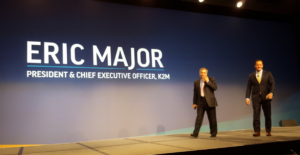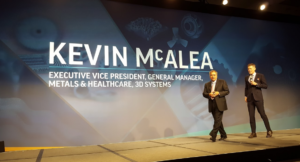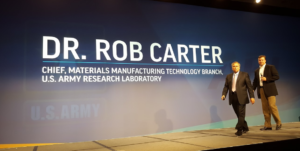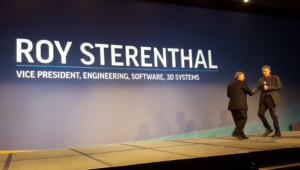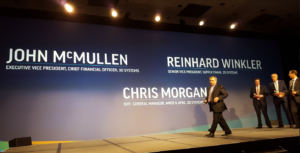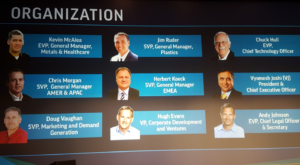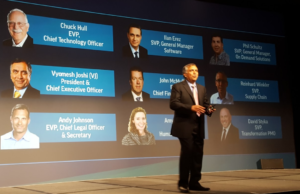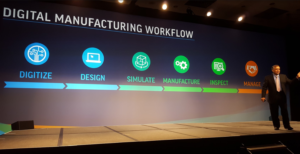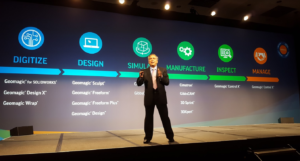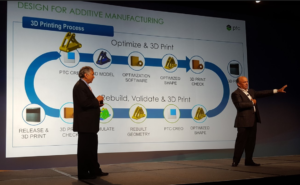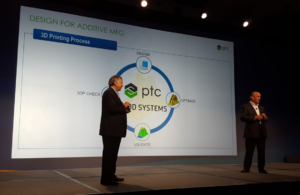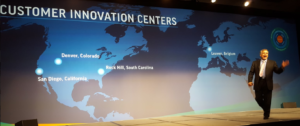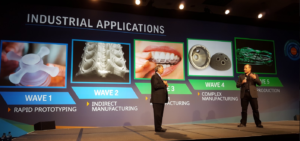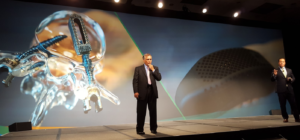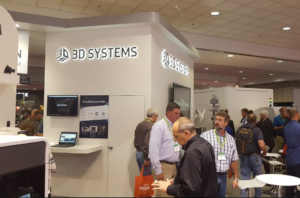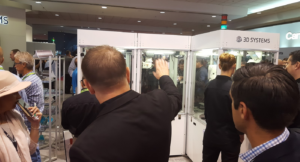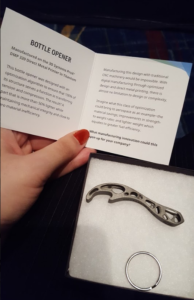Making 3D Production Real: 3D Systems Unveils In-Depth Plans to Go from Prototyping to Production at IMTS
While I had certainly been expecting big news, I had not necessarily anticipated the remarkable cast of characters in the morning’s proceedings. I have rarely been so grateful to have a front row seat to a presentation, as this busy announcement was enthralling. Not only did CEO Vyomesh Joshi (VJ) take to the stage for a full two-hour presentation, he was joined at every step by figures factoring into the entire history of 3D Systems — starting with the father of 3D printing himself, Chuck Hull. VJ moved fluidly through several topics, leaning on the team around him to demonstrate use cases, partnerships, and generally an impressive showing of forward momentum for the long-established, but not infrequently troubled, giant in the 3D printing industry.
 To begin, VJ noted that 3D Systems is focusing on five key segments for its strategy: Aerospace and Defense, Automotive, Healthcare, Durables, and Teaching and Training. The goal, it was soon clear, is a big step: to take 3D printing from prototyping to production. The keys to 3D production lie in productivity, durability, repeatability, and TCO (total cost of ownership). These key segments and production bases were the underlying themes for the morning’s presentation. VJ sees 3D printing as being presently at an inflection point, poised at the brink of a greater future and expansive adoption beyond rapid prototyping.
To begin, VJ noted that 3D Systems is focusing on five key segments for its strategy: Aerospace and Defense, Automotive, Healthcare, Durables, and Teaching and Training. The goal, it was soon clear, is a big step: to take 3D printing from prototyping to production. The keys to 3D production lie in productivity, durability, repeatability, and TCO (total cost of ownership). These key segments and production bases were the underlying themes for the morning’s presentation. VJ sees 3D printing as being presently at an inflection point, poised at the brink of a greater future and expansive adoption beyond rapid prototyping.
“The technology we have, the portfolio we have, can offer a complete solution, from plastics to metals,” VJ said, explaining that as far as hardware goes, “We have the broadest portfolio in the world.” On the software side, he noted that, “Ease of use is very important for our customers.”
The Figure 4 system from 3DS offers an expansive array of opportunities to users, and was based on a drawing found in the original patent for 3D printing, back in 1984.
It was at this point that VJ introduced Chuck Hull, a familiar figure best known as the ‘father of 3D printing.’ Below is a video from the presentation of the two discussing 3D Systems:
“Whenever I talk to Chuck, I learn so many new things,” VJ said.
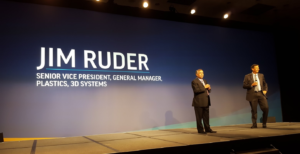 Next, VJ brought Jim Ruder up to the stage. Ruder, 3DS’ new Senior Vice President and General Manager of Plastics, has been with the company for about two months now. While a lot of the focus in the 3D printing industry has been on metals, Ruder and VJ speak for 3DS in noting that plastics will also maintain a very important part in the industry.
Next, VJ brought Jim Ruder up to the stage. Ruder, 3DS’ new Senior Vice President and General Manager of Plastics, has been with the company for about two months now. While a lot of the focus in the 3D printing industry has been on metals, Ruder and VJ speak for 3DS in noting that plastics will also maintain a very important part in the industry.
“Plastics will be a huge priority in production,” Ruder explained emphatically. “It’s a super opportunity.”
Areas that VJ wanted especially to emphasize to the gathered crowd centered around the workflow solutions that 3D Systems is striving to offer. A critical part of any successful workflow is the support services in place, which VJ recognizes as including the right people on the home team, as well as offering full training for channel partners. With an emphasis on investment, VJ explained that “We invest in people, we invest in technology,” and that the focus was on preventive, rather than reactive, maintenance; problems can be best avoided by having the right mechanisms in place from the start. “Process control is crucial as we move forward,” he noted.
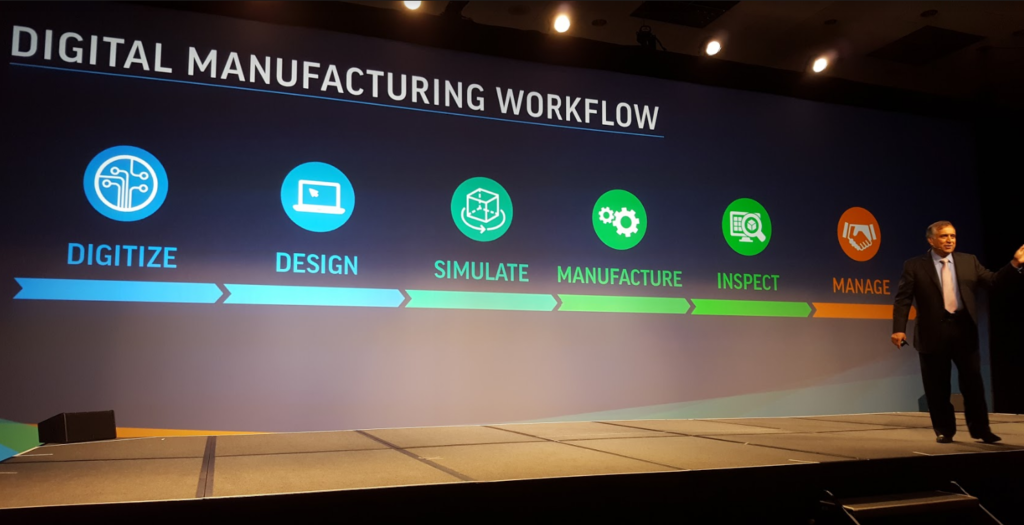 The next guests to join VJ on the stage, as he continued in a conversational manner with each to draw out their comments regarding their areas of expertise and focus, included partners from companies and organizations 3D Systems has been working closely with, as well as 3DS team members from across the broad operations offered, with several new-to-3DS faces among them. Joining VJ on stage were:
The next guests to join VJ on the stage, as he continued in a conversational manner with each to draw out their comments regarding their areas of expertise and focus, included partners from companies and organizations 3D Systems has been working closely with, as well as 3DS team members from across the broad operations offered, with several new-to-3DS faces among them. Joining VJ on stage were:
- Jim Heppelmann, President and CEO, PTC — Heppelmann presented the ‘yin and yang’ of operations, as the world is both physical and digital; bringing together not just 3D design and 3D printing, but also the IoT, augmented and virtual realities, and other technologies to optimize workflow, simplifying the process and cutting out unnecessary steps
- Karl Meyer, Vice President, Entertainment, 3D Systems — Meyer presented examples, from The Hunger Games to the latest installment of The Fast and the Furious, as to how 3D design removed limits that had been imposed on designers
- Patrick Dunne, Vice President, Advanced Application Development, 3D Systems — Dunne’s focus centered around moving beyond initial applications, from sacrificial molds to a digital injection molding machine, helping to answer VJ’s recurring question of “How do we make it real?”
- Jamie Hanson, Chief Operating Officer, Methods 3D — A channel partner, Hanson offered insight on Methods Machine Tools’ look at additive manufacturing as a complementary technology to traditional subtractive methods, noting that the company partnered with 3DS due to the “broad range of technology 3D Systems provides,” and calling Figure 4 “a game changer”
- Katie Weimer, Vice President, Medical Devices, Healthcare, 3D Systems — Weimer underscored the fact that many practical applications of production-ready 3D printing technology found its basis in the medical industry, where patient-specific healthcare has been a huge benefit, from digitization to surgical simulations. She noted that the case of the world’s most complex face transplant last year benefited from the entire workflow available from 3D Systems
- Eric Major, President and CEO, K2M — Starting with a look at 3D printed titanium spinal implants, Major noted that 3D capabilities remove months from the process of patient-specific production, and that K2M offers the most comprehensive portfolio of these devices with FDA clearance
- Kevin McAlea, Executive Vice President, General Manager, Metals & Healthcare, 3D Systems — McAlea focused on the metals solutions that 3DS offers, noting of their metals portfolio that “we got into it a little late through acquisitions” and highlighting the critical nature of understanding the dynamics and specific needs of each vertical, optimized for each application
- Dr. Rob Carter, Chief, Materials Manufacturing Technology Branch, US Army Research Laboratory — VJ noted that 3DS is “uniquely positioned here in the United States” through being able to partner with the US military for development, and Dr. Carter noted that next-generation low-weight metal alloys, high-temperature SLS and perhaps biocompatible, and multi-jet technologies gained through partnerships with 3DS and the Walter Reed Medical Center help the Army to minimize necessary parts and look toward point-of-need manufacturing
- Roy Sterenthal, Vice President, Engineering, Software, 3D Systems — Sterenthal noted a “new approach designed to remove existing barriers and simplify workflow” with work on slicing and post-processing, as well as zoning as an approach to define different qualities in each part, with emphasis on 3DXpert
Finally, following all of these on-stage conversations, VJ showed the entirety of the current 3D Systems management team, which he has been focusing his energy on optimizing, following massive shakeups within the last several months in the corporate structure.
“We have the right strategy,” VJ enthused, “I need to make sure we have the right team. We need the best, world-class team.”
To highlight the efforts put in here, VJ brought to the stage three members of his dream team, introducing John McMullen, Executive Vice President and Chief Financial Officer; Reinhard Winkler, Senior Vice President, Supply Chain; and Chris Morgan, SVP and General Manager, Amer and APAC. The three joined VJ in a conversation about the operational framework in place, as well as the capital of the company in terms of both finances and human capital.
“With a great team,” VJ said, “we can make 3D production real.”
 Following the full presentation, I had the opportunity to sit down with VJ and talk with him about the day’s announcements. As expansive as the presentation had been, I still had A Few Questions For him to discover more about his unique insights into all that had just transpired. Below is a transcript of my interview with VJ:
Following the full presentation, I had the opportunity to sit down with VJ and talk with him about the day’s announcements. As expansive as the presentation had been, I still had A Few Questions For him to discover more about his unique insights into all that had just transpired. Below is a transcript of my interview with VJ:
What do you hope to be the biggest takeaway from today’s presentation?
The main takeaway is three big points.
- We’re at an inflection point, where things will go from prototype to production. It’s a journey, it’s not going to be overnight. Over the next three years, we are going to work with customers to really find meaningful applications. That’s the first thing that I would say.
- The second thing is that 3D Systems is focused on partnership, and getting all the assets into a way where we will be able to get the workflow and focus on the production technologies. That’s the portfolio I was talking about, and partnership is very important for that.
- Third thing is, we are building a great team where we are focused on execution. Take the cost out, invest into the growth.
Those are the three things. It’s actually very simple, you know, it’s not that complicated.
When you came onboard at 3D Systems, what excited you the most about being at the helm of this company?
I think the most exciting thing was the technology portfolio. I think Chuck Hull — I said that on the stage, I really do think, he’s my CTO but he’s way more than that. He created this exciting opportunity. He’s continued to innovate. That is the single most thing.
You’ve had a very dedicated approach, particularly to your management team. We’ve seen a lot of shakeups in the structure of the entire company, top down. How has the process been for you?
I always believe that form follows function. The first thing that I did was spend a lot of time talking to our employees, talking to our customers, talking to our partners, and review the technology portfolio, review the talent I have, and what needs to be done. That’s form follows function. I had a conversation with Kevin, with Katie, with Chuck, with everybody. I said, okay, this is the model, this is how I’m going to integrate all of the companies, this is the strategy that you saw today. Now, I’m going to organize around that. For that, what do I need, and what do I not have? The people I talked to, they all are very experienced people, they are all excited, working with me, working with the company. This is a tremendous opportunity.
Can you speak more to your vision beyond prototyping?
You can’t do that as a platform, you have to do that by segment. The five segments, aerospace and defense, automotive, healthcare, durable goods, teaching and training institutes — use case by use case, you start with the customer. We say, ‘Okay, you are looking for complexity that you want to be addressing, you want to integrate the parts, this is something you want to do, mass customization.’ Depending on that, do we have the right material, right hardware, right software, right application? You saw what Patrick Dunne and the team have done, an excellent job. Then we say, ‘Okay, do you want to try to do that in-house or do you want to use our on-demand solutions capability?’ So we can show you the way you want to do that and that’s how we’re going to take use case by use case. Enough use cases are flipping, it will become a platform. Once it’s a platform, then things will start really changing. That’s what I believe, in the next three years. In my mind, it’s very clear, what we need to do.
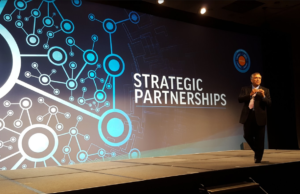 Partnerships are obviously key to moving everything forward. What do you look for in potential partners?
Partnerships are obviously key to moving everything forward. What do you look for in potential partners?
There are three things I look for. We need to have a common vision, in the company. I’m looking for a win-win partnership. The second thing is we need to have clarity in what we do and what the partner does. If we don’t have clarity, we trip on each other. The third thing is, it needs to be done all the way down from CEO to individual contributor. Then we will be able to really measure it and then look at why it’s going to help our customer. At the end of the day we are doing it for our customer, and because we are delighting the customer, it shows the economic value of the partnership, that’s how I think about it. This is what you saw with PTC, right? Jim and I, we just met two and a half months ago, and you can see how we immediately work together, to delight the customer. We can really make this thing work, this is the greatest example of how we build that partnership.
Where does Figure 4 come into play?
Have you seen it yet? Go look at the booth! Metal’s already showing, like in the healthcare example, and we need that innovation in plastics. Chuck’s vision was very clear, SLA technology is the technology that can make that happen. The four key user types I talked about, productivity, durability, repeatability, and total cost of operation, you’ve got to have very fast. You’ve got to have the right materials, that’s where the innovation is, so you can have durability and repeatability. The analogy I gave, a multi-cavity digital mold, having that digital engine, that kind of multi-cavity, that’s how we are building the architecture. It’s not a little machine, it’s really a line, and you could integrate the post-processing and all that. When we showed the customer — Jamie talked about that, he said, ‘whoa, this is different.’ That’s why we are very excited, this is really transformative.
What have you most been looking forward to most about IMTS this year?
I think the customers are really saying, ‘Oh, what is this additive manufacturing?’ We used to go to drupa, this show, and see analog to digital. I remember vividly in the ’90s, Heidelberg had a big booth and we had a tiny booth, and at this last drupa, we are the biggest booth and Heidlelberg were the smallest. My view is the penetration of additive technology and really how we can go from prototyping to production and how it enables the innovation; it’s not about additive technology, it’s about the innovation. It’s what I would look for. I would say at IMTS we should measure that.
Following my chat with VJ, I was able to spend some time at the 3DS booth — mostly their main location, right at the front of hall B, though 3DS tech also appears at at least two other booths at IMTS — to watch the mesmerizing Figure 4 in action, as well as revisit many of their other 3D printers and talk some more with the team. You can sign up for your own booth tour here.
IMTS is still going on through the end of this week, and if you’re in Chicago, it’s certainly worth the stop. Be sure to stoop by to see all that’s going on in additive manufacturing, and check out the 3D Systems booth!
3DS also introduced their Control X software this week, which is a big step toward 3D inspection and metrology. To learn more about VJ’s presentation and the company’s vision for prototyping to production, the full presentation of the 2016 Strategy and Solutions Event is available on 3DS’ Investor Relations page, including slides and a full webcast of the event.
[All photos and videos in this article taken on-site at IMTS by Sarah Goehrke for 3DPrint.com]- The team gathered from 3D Systems and their partners, ready to take to the stage
- VJ talking with Chuck Hull
- The workflow currently requires many steps…
- …but PTC and 3DS illustrate how this could be optimized
- 3DS offers innovation centers around the world
- The 3DS booth at IMTS 2016
- My new 3D printed titanium bottle opener — incredible detail
Subscribe to Our Email Newsletter
Stay up-to-date on all the latest news from the 3D printing industry and receive information and offers from third party vendors.
You May Also Like
Precision at the Microscale: UK Researchers Advance Medical Devices with BMF’s 3D Printing Tech
University of Nottingham researchers are using Boston Micro Fabrication‘s (BMF) 3D printing technology to develop medical devices that improve compatibility with human tissue. Funded by a UK grant, this project...
3D Printing Webinar and Event Roundup: April 21, 2024
It’s another busy week of webinars and events, starting with Hannover Messe in Germany and continuing with Metalcasting Congress, Chinaplas, TechBlick’s Innovation Festival, and more. Stratasys continues its advanced training...
3D Printing Webinar and Event Roundup: March 17, 2024
It’s another busy week of webinars and events, including SALMED 2024 and AM Forum in Berlin. Stratasys continues its in-person training and is offering two webinars, ASTM is holding a...
3D Printed Micro Antenna is 15% Smaller and 6X Lighter
Horizon Microtechnologies has achieved success in creating a high-frequency D-Band horn antenna through micro 3D printing. However, this achievement did not rely solely on 3D printing; it involved a combination...


